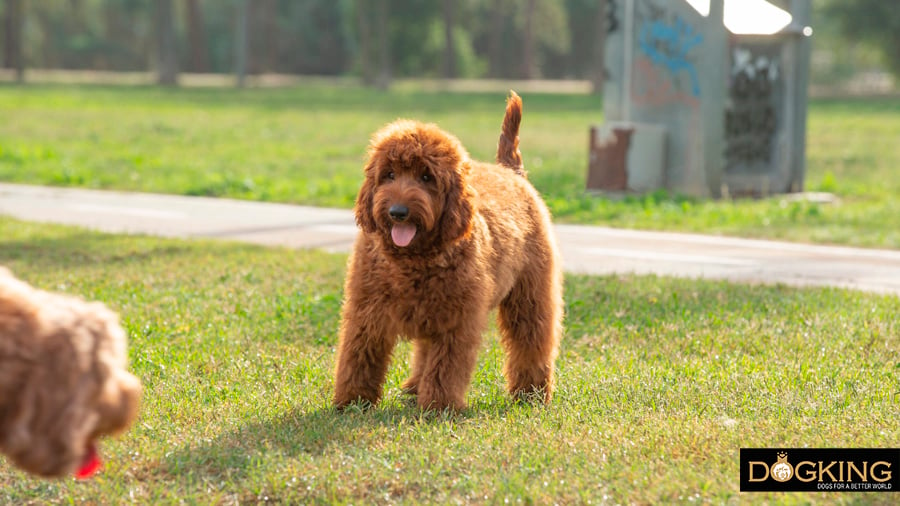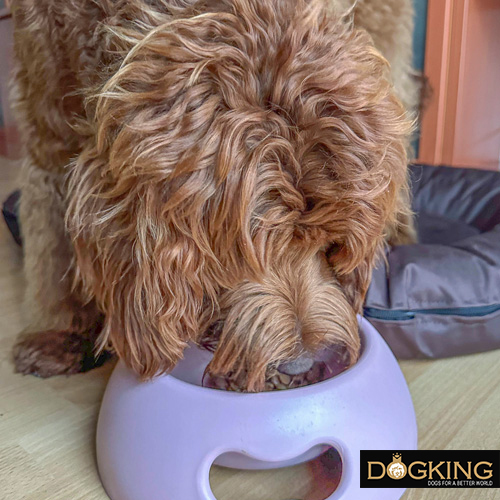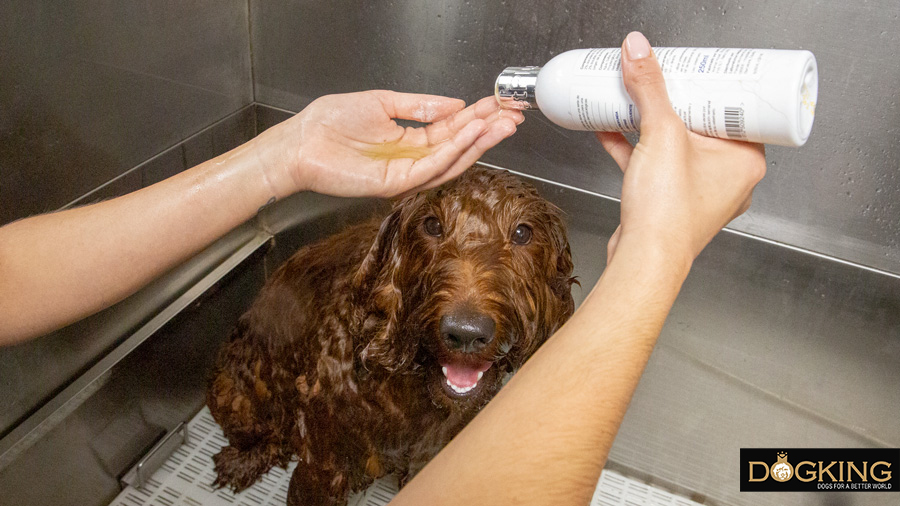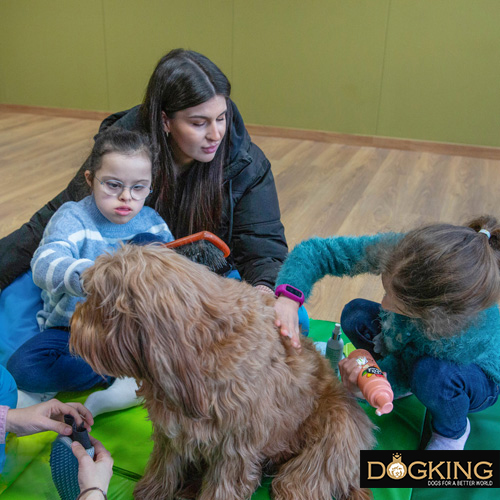How to improve your dog’s coat shine and its health
What you should know about maintaining a dog's coat

HOW TO IMPROVE THE SHINE AND HEALTH OF YOUR DOG'S COAT
Reading time about 7 minutes
Caring for your dog as it deserves also means attending to the needs of its coat.
This won’t only make it look good, but will also prevent major health problems affecting its skin, help your dog get used to hygienic habits, and improve the bond between the two of you.
In the following article we give you the keys to keeping your canine's coat shiny and, above all, healthy.

Table of contents
1- Requirements for a healthy and shiny hair
2- The importance of canine hair maintenance
3- What if my dog is still a puppy?
Requirements for a healthy and shiny hair
Quality food
 The way you take care of yourself on the inside is reflected in how you look on the outside, also in the case of dogs. If our pet has a nutrient-poor diet, its coat will probably look dry, dull, and with a tendency to fall out. To avoid this, its diet should be rich in fatty acids, salts, zinc, iodine, vitamins A, B, C and E, omega 3 and omega 6. Foods such as sardines, salmon, carrots or egg yolk are highly recommended by experts, and may be found mostly in quality feed. Even so, it is always best to consult your trusted veterinarian to better adapt to the individual needs of each dog and to provide vitamin supplements if required.
The way you take care of yourself on the inside is reflected in how you look on the outside, also in the case of dogs. If our pet has a nutrient-poor diet, its coat will probably look dry, dull, and with a tendency to fall out. To avoid this, its diet should be rich in fatty acids, salts, zinc, iodine, vitamins A, B, C and E, omega 3 and omega 6. Foods such as sardines, salmon, carrots or egg yolk are highly recommended by experts, and may be found mostly in quality feed. Even so, it is always best to consult your trusted veterinarian to better adapt to the individual needs of each dog and to provide vitamin supplements if required.
Regular trimming and brushing
In order for the new hair to be of good quality and to grow healthily, the skin must be ventilated and have proper circulation, which is achieved primarily through brushing and trimming.
The number of times a dog should be brushed varies between one and seven times a week, depending mainly on two factors: the breed and the length of the hair. If it is a long-haired type, it will require a minimum of one brushing a day as the tendency to tangle will be greater, especially after the walk. As a guide, a well-brushed coat will be the opposite of a matted coat that lacks of sweating, that is, it doesn’t allow you to see the dog's skin once you try to open it with your hands. In order to avoid matting, brushing should be done in layers and all knots should be removed, using your fingers or a metal comb in case of greater resistance to get rid of. Specifically, insert the tip of the comb into the root of the knot and gradually pull it outwards, opening it with the help of the fingers if necessary.
In this way, we will avoid the need to trim it, we will eliminate dirt, and it gives the coat a shiny appearance. It should also be added that special attention should be paid to the type of tool used, as one brush or another won’t be equally effective for all dogs. For small dogs or dogs with more fragile or curly hair, it is better to use a round bristle brush, while for larger dogs with long hair it is more convenient to use a slicker brush, as shown in the following video.
As for haircuts, especially for longer coats, monthly grooming sessions are recommended to promote a shinier and healthier coat.
On the other hand, and although short hair may seem easier to tame or not require so much brushing, as it is often thicker, it may hide certain problems in our dog's skin such as bumps, parasites or wounds that require special attention. In addition, it should be noted that all types of fur get dirty by accumulating dust and absorbing bad smells. For all these reasons, it will be important that hygiene routines are carried out on a recurring basis whatever the length or type of hair.
Specific cleaning products
One of the biggest mistakes when it comes to caring for our dog's coat is using products for humans, whether they are shampoos or shower gels. They aren’t only aggressive for their fur, but also for the health of their skin by causing irritation or even severe injuries. Therefore, we must always choose shampoos for dogs, if possible specific to their particular hair type, age, colour, length, etc.
There are also functional shampoos, whether they are hypoallergenic, anti-hair loss, nourishing, anti-dandruff, or anti-parasites, among others; to guarantee the hair and individual health of your dog. Besides, it isn’t always possible to use neutral shampoos with generalized formulas, but we should take into account the type of skin and coat that our pet has, as it may need something more specific.
To provide extra shine and hydration when brushing, we may also apply perfumes made from oil, and at bath time we may use balms that nourish both skin and coat after shampooing.

Cleaning routines
As far as bathing is concerned, there is no specific number of washes to be followed beyond the aforementioned monthly visit to the groomer.
However, it all depends on the lifestyle and specific needs of each dog. If it is, for example, a puppy that is still in the process of learning to relieve itself hygienically, or a dog who is exposed to foul-smelling elements on a daily basis, it may require a greater number of washes and brushings. It is always advisable to visit the groomer for an initial individual advice. If the dog lives indoors in the presence of children or people with delicate health, and as it applies to our therapy dogs, weekly shampoos should be necessary. If this is the case, however, we should rely on the recommendation of our groomer for the use of a shampoo that prevents damage to the dog's pH.
In addition, it is important that brushing is carried out before and after the bath, but always with a dry brush. It is very important not to skip the step of doing it before, as this will allow the shampoo to be better distributed throughout the hair as there will be no tangles and if there is a knot, we will undo it beforehand to prevent it from closing too tightly. Brushing our dog with the coat still wet would make it difficult to undo the knots, which could be annoying or even painful for our dog.
Finally, if your dog has long hair, you should pay attention to one more detail: its ears. They also tend to accumulate hair in this area as a defence mechanism against possible foreign bodies that may enter the inside of their ears. This hair may lead to more wax, dirt or insufficient sweating in their ears, so they should also be cleaned frequently.
The importance of canine hair maintenance
 Daily hair care isn’t only important for people, it is also important for our dogs. By doing so, we won’t only be able to avoid dirt, bad smell, tangles, and possible parasites that could threaten their health; but also, these routines mean a time dedicated exclusively to it strengthening the relationship between the two. Especially with dogs like the Australian Cobberdogs, the best reward you may give them is your time and love. In fact, brushing is one of the activities that we carry out in our assisted therapies and which stands out for improving the mood of children with needs regardless of the condition of the hair of the dog in question.
Daily hair care isn’t only important for people, it is also important for our dogs. By doing so, we won’t only be able to avoid dirt, bad smell, tangles, and possible parasites that could threaten their health; but also, these routines mean a time dedicated exclusively to it strengthening the relationship between the two. Especially with dogs like the Australian Cobberdogs, the best reward you may give them is your time and love. In fact, brushing is one of the activities that we carry out in our assisted therapies and which stands out for improving the mood of children with needs regardless of the condition of the hair of the dog in question.
What if my dog is still a puppy?
Since they are little, it is important to take advantage of the socialization period to accustom our furry friends to correct hygiene routines. Contact with water, the soapy mitten, the brush, or the hair dryer are some of the elements that every dog should associate with positive experiences, especially in a stage so full of first times. At DOGKING, for example, we make sure that the puppy delivered to every family has already included bath time in its learning process. And beyond using the best products, the fact that your dog isn’t used to or hasn’t internalized this routine will probably make it difficult for both you and your dog to carry out its care.
In order to ensure optimum care of Australian Cobberdogs, it is important to differentiate between the tools needed to care for an adult dog and those used for puppies. Being shorter and still fine, a puppy's hair will require less power and heat when using either a hair dryer or a dog air ejector. In this first stage we should make use of a metal comb and a slicker brush with protected teeth so as not to damage their delicate skin. As the puppy's hair grows (around 5-6 months) depending on the animal, the brushing will have to be done in layers to avoid tangles in the inner layers. We explain everything in greater detail in the following video:
Despite all the above, the most advisabe thing to do is always go to a session with our groomer so that he/she may explain in detail the steps, tools and product recommendations that best fit our dog at all stages.